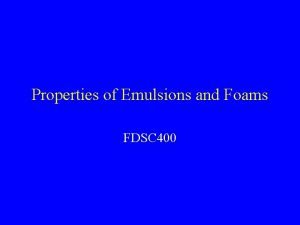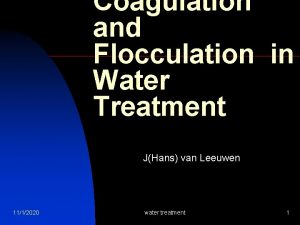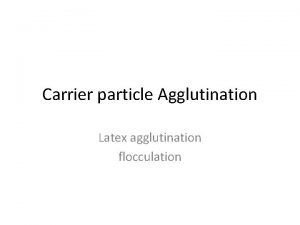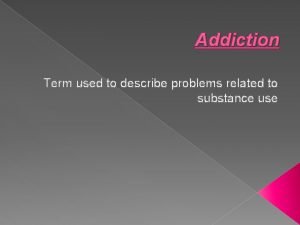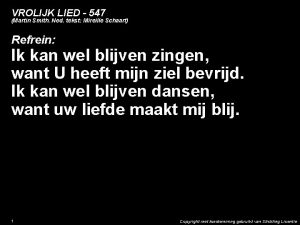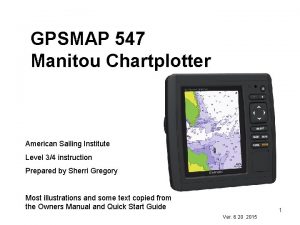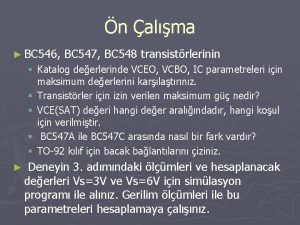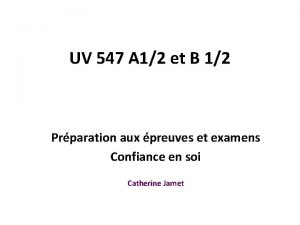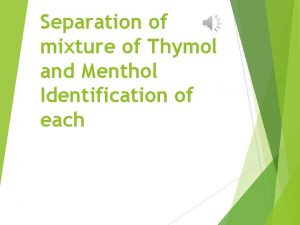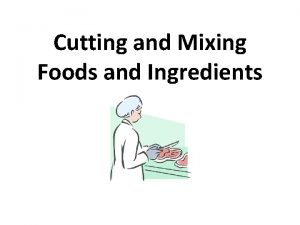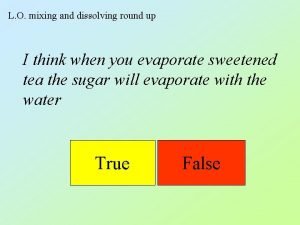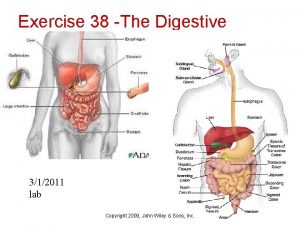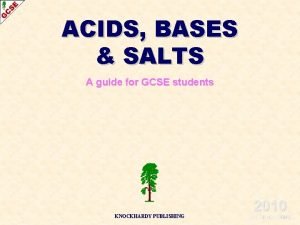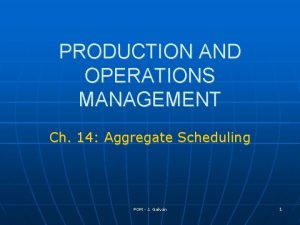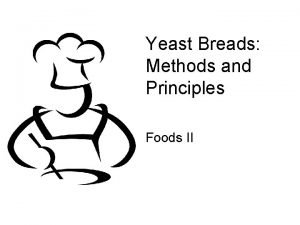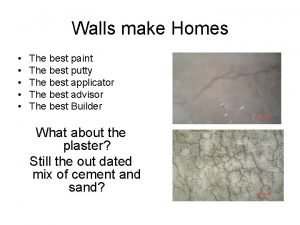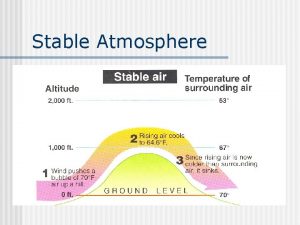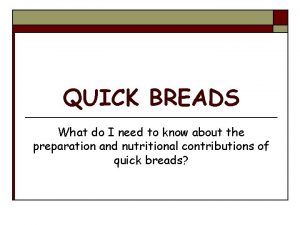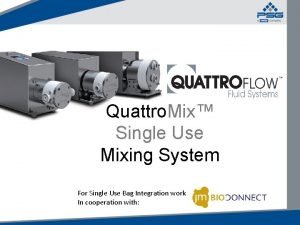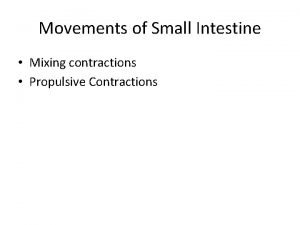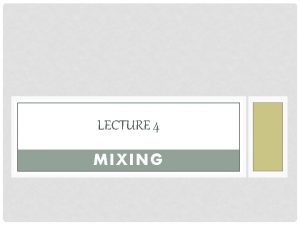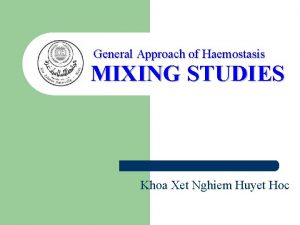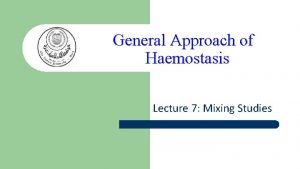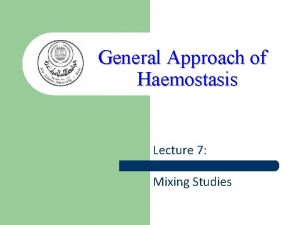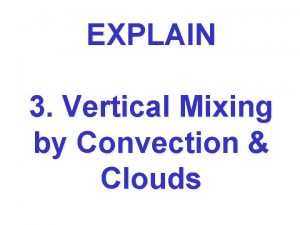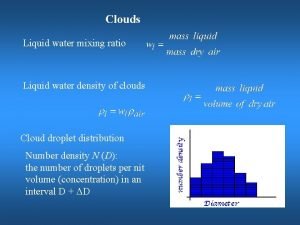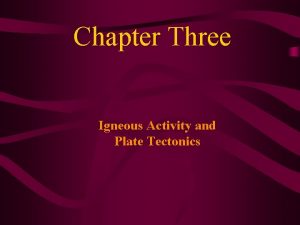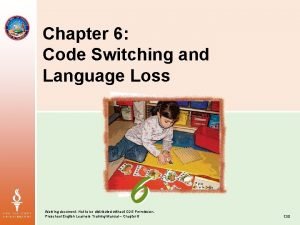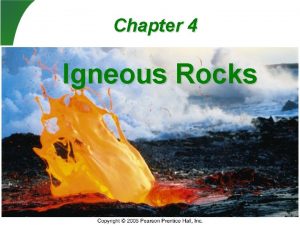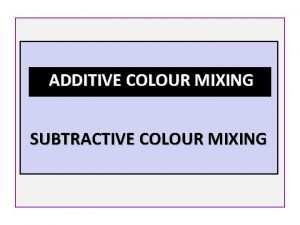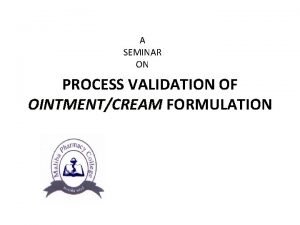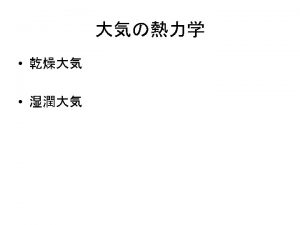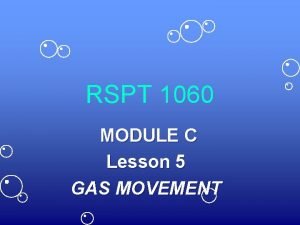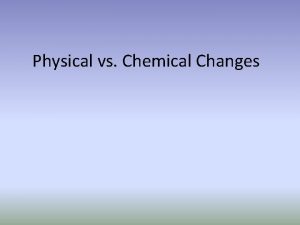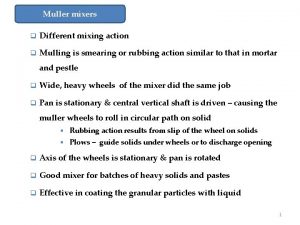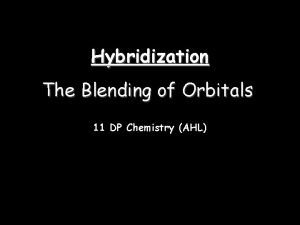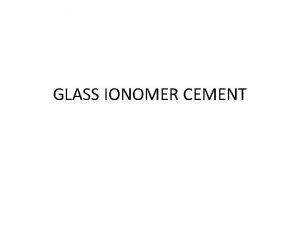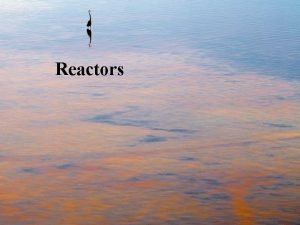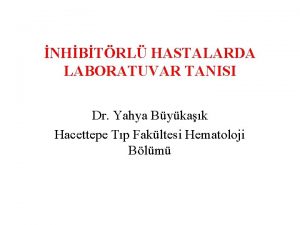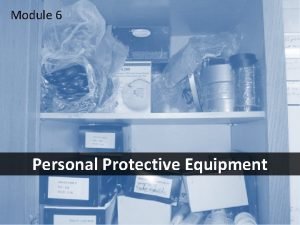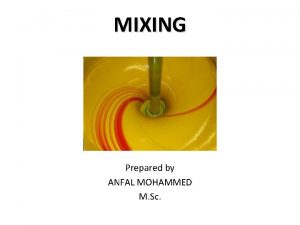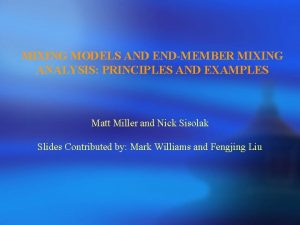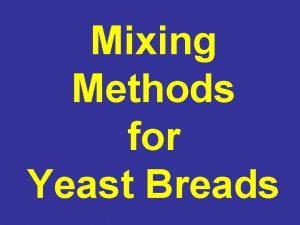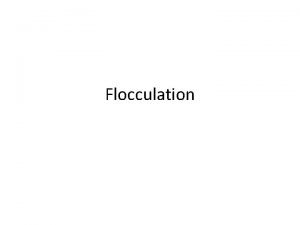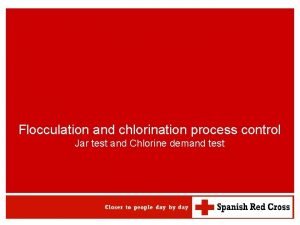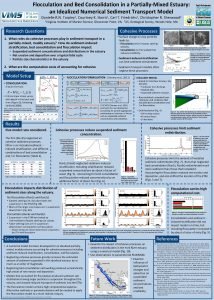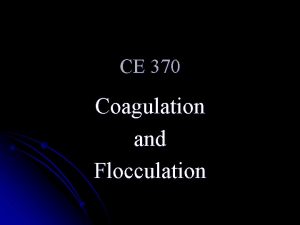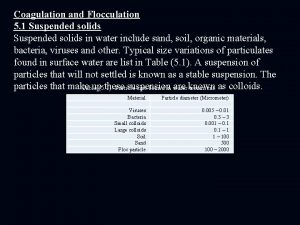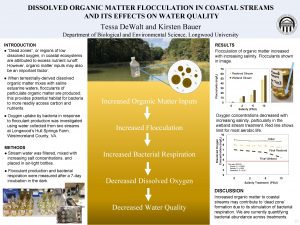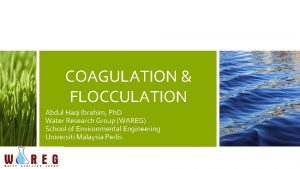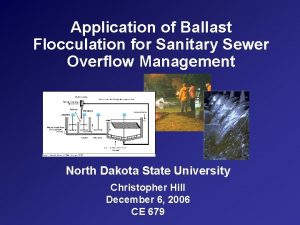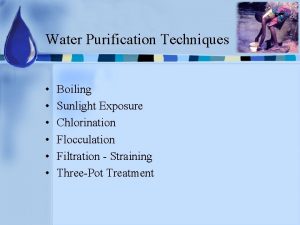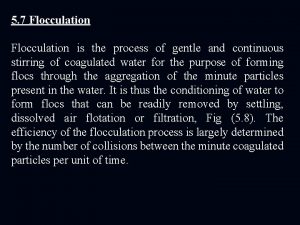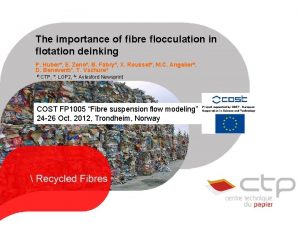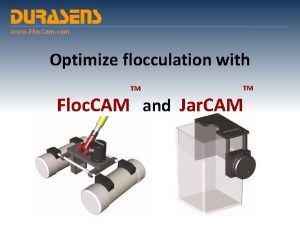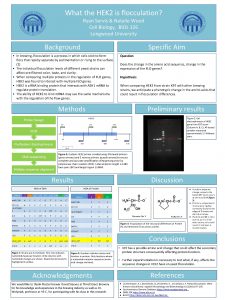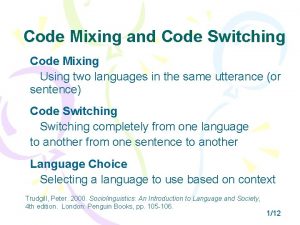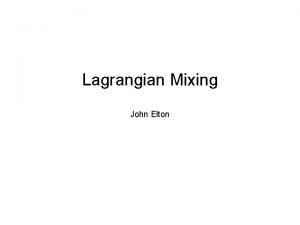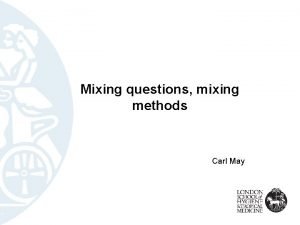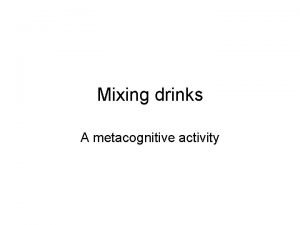CE 547 Mixing and Flocculation 1 Mixing Is























































- Slides: 55

CE 547 Mixing and Flocculation

1. Mixing Is a unit operation that distributes the components of two or more materials among the materials producing in the end a single blend of the components. Mixing is accomplished through agitation. Type of mixers: n n n rotational (rotational elements) pneumatic (gas or air bubbles) hydraulic (flowing of water) 2. Flocculation Is a unit operation aimed at enlarging small particles through a very slow agitation. Flocculation is accomplished through the use of large paddles.



Mixing

A. Rotational Mixers Impellers are used in rotation mixing. Types of impellers are (Fig 6. 2): a. propellers n n n standard three-blade guarded weedless b. Paddles n flat paddle c. Turbines n n straight blade curved blade vaned-disk shrouded blade


Flow Pattern in Rotational Mixers (Fig 6. 3) n fluid is thrown towards the wall n fluid is deflected up and down n flow returns back to the blades (circulation rate) Prevention of Swirling Flow (Fig 6. 4) n putting the agitator eccentric to the vessel n using a side entrance to the vessel n putting baffles along the vessel wall



Power Dissipation in Rotational Mixers P = function of (N, Da, g, , ) P = power dissipated N = rotational speed Da = diameter of impeller g = acceleration due to gravity = absolute viscosity = mass density

If Re 10 At high Re KL and KT are constants (Power coefficients)

Dt = Diameter of Vessel; W = Width of Paddle; J= Width of baffle

Example 6. 1


B. Criteria for Effective Mixing G = average velocity gradient in the tank V = volume of tank P = power dissipated = absolute viscosity

G Criteria Values for Effective Mixing t 0 (seconds) G (s-1) < 10 4000 – 1500 10 – 20 1500 – 950 20 – 30 950 – 850 30 – 40 850 – 750 40 – 130 750 – 700 t 0 = detention time of the tank

C. Pneumatic Mixers This is accomplished using diffused aerators (Fig 6. 7) porous ceramic tube n coarse bubble n open pipe n perforated pipe n fine bubble n saran wrapped tube n diffused aeration schematic n


Pneumatic mixing power = function (number of bubbles formed) n = number of bubbles Pi = input pressure to the unit Qi = input flow to the unit Pa = atmospheric pressure b = average rise velocity of bubbles h = depth of submergence of air diffuser Vb 0 = average volume of bubble at surface

b is described in terms of three dimensionless quantities, G 1, G 2 and Re G 1 = Peebles number G 2 = Garber number = surface tension of fluid r = average radius of bubbles


Power Dissipation in Pneumatic Mixers Qi = input flow to the unit (air) l = specific weight of water

Example 6. 2


D. Hydraulic Mixers This is accomplished by the use of energy of a flowing fluid to create the power dissipation required for mixing. Types of hydraulic mixers include: hydraulic jump mixer n weir mixer n



Power Dissipation in Hydraulic Mixers hf = fluid friction loss Q = flow rate = specific weight

For hydraulic jump (Fig 6. 9) q = flow per unit width of the channel

Using the momentum equation Solving for y 1 and y 2, then


Examples 6. 3 and 6. 4



For weirs (Fig 6. 10) H = head over the weir crest HD = drop provided from weir crest to surface of the water below Then

Examples 6. 5 and 6. 6



Flocculators

n n n Agitation in flocculation involves gentle motion of the fluid to induce agglomeration of smaller particles into larger flocs Small flocs build into larger sizes until a point reached where the size can not go on increasing (critical size) Critical size depends on: n n n Detention time (larger detention time produce larger critical sizes) Velocity gradient (larger velocity gradients produce smaller critical sizes) Critical values for effective flocculation are expressed in terms of: n n Gt 0 and G

Critical Values for Effective Flocculation G (s-1) Type of Raw Water Gt 0 (dimensionless) Low turbidity and colored 20 – 70 50, 000 – 250, 000 High turbidity 70 - 150 80, 000 – 190, 000


n n n n Compartments vary in size (from smaller to larger) G decreases instead As flow gets larger, rotation of paddle must be made slower to avoid breaking up the flocs The number of blades decrease also as water moves from compartment to another If FD is drag by water on the blade and FD is also the push of the blade upon the water Due to that, water will move at a velocity p equal to the velocity of blade Since paddle is rotating, ( p) is a tangential velocity

rp = radial distance to rotational axis = angular rotation (radians / time) CD = drag coefficient Ap = projected area of blade in the direction of its motion = mass density of water

Total power = sum of powers in each blade Apt = sum of projected area of blade pt = blade tip velocity

n n n Due to location of blades, there will be several p’s To use one velocity, pt, is used multiplied by a factor (a), [ a = 0. 75 ] G and Gt 0 are to be checked to see if the flocculator performs at conditions of effective flocculation Paddle tip velocity should be less than 1. 0 m/sec CD is a function (Re) p = blade velocity n = kinematic viscosity n

For one single blade at Re = 105 CD = for multiple blades must be determined

Example 6. 7






 Flocculation geography definition
Flocculation geography definition Mechanical flocculator design
Mechanical flocculator design Flocculation test syphilis
Flocculation test syphilis Flocculation delirium
Flocculation delirium Lied 547
Lied 547 Dpr 547/55
Dpr 547/55 American sailing institute
American sailing institute древногръцки философ 624 547
древногръцки философ 624 547 Bc 546
Bc 546 547*12
547*12 In the mixing of thymol and menthol
In the mixing of thymol and menthol Cutting and mixing food items examples
Cutting and mixing food items examples Mixing red and green marbles physical or chemical change
Mixing red and green marbles physical or chemical change Mixing and dissolving
Mixing and dissolving Exercise 38 review sheet art-labeling activity 3 (1 of 2)
Exercise 38 review sheet art-labeling activity 3 (1 of 2) Soluble salts can be made by mixing acids and alkalis
Soluble salts can be made by mixing acids and alkalis Tools for mixing blending straining and rolling
Tools for mixing blending straining and rolling Key tactics in choosing different brand elements
Key tactics in choosing different brand elements Code mixing
Code mixing Counterseasonal product and service mixing
Counterseasonal product and service mixing Soft medium dough examples
Soft medium dough examples What is spot stocking
What is spot stocking Ramco super plaster mixing ratio
Ramco super plaster mixing ratio Mixing height meaning
Mixing height meaning What do fats/shortening do in yeast breads
What do fats/shortening do in yeast breads Single use mixing
Single use mixing Herbicide mixing cheat sheet
Herbicide mixing cheat sheet Peristaltic contraction
Peristaltic contraction Propeller mixer definition
Propeller mixer definition Mixing studies
Mixing studies Mixing study interpretation
Mixing study interpretation Aptt mixing study
Aptt mixing study Conditionally unstable atmosphere
Conditionally unstable atmosphere Cloud mixing ratio
Cloud mixing ratio Magma mixing
Magma mixing Code switching definition
Code switching definition Magma mixing
Magma mixing Subtractive colour theory
Subtractive colour theory Solid and
Solid and Water vapor mixing ratio
Water vapor mixing ratio Bezold effect
Bezold effect Entrainment ratio formula
Entrainment ratio formula Is mixing kool aid a chemical change
Is mixing kool aid a chemical change Mixing in action
Mixing in action Hybridization of formaldehyde
Hybridization of formaldehyde Gic setting reaction
Gic setting reaction Shunt feedback amplifier analysis
Shunt feedback amplifier analysis Diffie hellman color mixing
Diffie hellman color mixing Methods of cookies
Methods of cookies Conservative mixing
Conservative mixing Oa air washer
Oa air washer Prof dr yahya büyükaşık
Prof dr yahya büyükaşık A worker mixing chemicals must not wear
A worker mixing chemicals must not wear Turbine mixer disadvantages
Turbine mixer disadvantages End member mixing analysis
End member mixing analysis Mixing methods for yeast breads
Mixing methods for yeast breads
